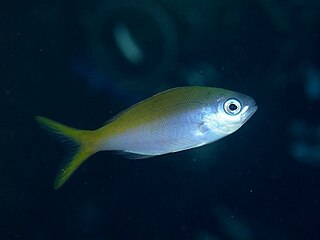
Cyprinidae is a family of freshwater fish commonly called the carp or minnow family, including the carps, the true minnows, and their relatives the barbs and barbels, among others. Cyprinidae is the largest and most diverse fish family, and the largest vertebrate animal family overall, with about 3,000 species; only 1,270 of these remain extant, divided into about 200 valid genera. Cyprinids range from about 12 mm (0.5 in) in size to the 3 m (9.8 ft) giant barb. By genus and species count, the family makes up more than two-thirds of the ostariophysian order Cypriniformes. The family name is derived from the Greek word kyprînos.

The Cottidae are a family of fish in the superfamily Cottoidea, the sculpins. It is the largest sculpin family, with about 275 species in 70 genera. They are referred to simply as cottids to avoid confusion with sculpins of other families.

Gouramis, or gouramies, are a group of freshwater anabantiform fish that comprise the family Osphronemidae. The fish are native to Asia—from the Indian Subcontinent to Southeast Asia and northeasterly towards Korea. The name "gourami", of Indonesian origin, is also used for fish of the families Helostomatidae and Anabantidae.

The Congridae are the family of conger and garden eels. Congers are valuable and often large food fishes, while garden eels live in colonies, all protruding from the sea floor after the manner of plants in a garden. The family includes over 220 species in 32 genera.

The Carangidae are a family of ray-finned fish that includes the jacks, pompanos, jack mackerels, runners, trevallies, and scads. It is the largest of the six families included within the order Carangiformes. Some authorities classify it as the only family within that order but molecular and anatomical studies indicate that there is a close relationship between this family and the five former Perciform families which make up the Carangiformes.

Hexagrammidae, the greenlings, is a family of marine ray-finned fishes belonging to the suborder Cottoidei in the order Perciformes. These fishes are found in the North Pacific Ocean.

Anablepidae is a family of ray-finned fishes which live in brackish and freshwater habitats from southern Mexico to southern South America. There are three genera with sixteen species: the four-eyed fishes, the onesided livebearers and the white-eye, Oxyzygonectes dovii. Fish of this family eat mostly insects and other invertebrates.

The dottybacks are a family, Pseudochromidae, of fishes which were formerly classified in the order Perciformes, but this has been revised and the family is regarded as of uncertain affinities, or incertae sedis within the Ovalentaria, a clade within the Percomorpha. Around 152 species belong to this family.
Black snapper is a common name for a fish.
The Japanese snapper is a species of marine ray-finned fish, a snapper belonging to the family Lutjanidae. It is native to the Western Pacific Ocean.

Tokiharu Abe was a Japanese ichthyologist and a government official of Ministry of Agriculture and Forestry.

The Gobiiformes are an order of fish that includes the gobies and their relatives. The order, which was previously considered a suborder of Perciformes, is made up of about 2,211 species that are divided between seven families. Phylogenetic relationships of the Gobiiformes have been elucidated using molecular data. Gobiiforms are primarily small species that live in marine water, but roughly 10% of these species inhabit fresh water. This order is composed chiefly of benthic or burrowing species; like many other benthic fishes, most gobiiforms do not have a gas bladder or any other means of controlling their buoyancy in water, so they must spend most of their time on or near the bottom. Gobiiformes means "goby-like".

Lutjanidae or snappers are a family of perciform fish, mainly marine, but with some members inhabiting estuaries, feeding in fresh water. The family includes about 113 species. Some are important food fish. One of the best known is the red snapper.

Batomorphi is a clade of cartilaginous fishes, commonly known as rays, this taxon is also known as the superorder Batoidea, but the 5th edition of Fishes of the World classifies it as the division Batomorphi. They and their close relatives, the sharks, compose the subclass Elasmobranchii. Rays are the largest group of cartilaginous fishes, with well over 600 species in 26 families. Rays are distinguished by their flattened bodies, enlarged pectoral fins that are fused to the head, and gill slits that are placed on their ventral surfaces.

Paracaesio is a genus marine ray-finned fishes, snappers belonging to the family Lutjanidae. They are native to the Indian Ocean and the western Pacific Ocean, with these currently recognized species:
Patricia J. Kailola is a noted ichthyologist. Her primary focus is in tropical Indo-Pacific fishes. She has worked in the Marine Studies program at the University of the South Pacific since 1995 and is an Australian Museum Research Associate. Among her numerous publications are listed several books covering tropical fish. She also has written texts on catfish. As of April 2006, she was working on a textbook on Western Indian Ocean fishes. She has assisted the Australian Museum in confirmation of species identification among their collection. Worldcat.org lists 27 works in 57 publications in 1 language and 603 library holdings.

Microcotylinae is a subfamily within family Microcotylidae and class Monogenea. This subfamily was created by Taschenberg in 1879.

Acanthuriformes is an order of ray-finned fishes, part of the Percomorpha clade. Some authorities place the fishes in the order within the Acanthuriformes in the suborders Acanthuroidea and Percoidea of the order Perciformes.

The African forktail snapper, is a species of marine ray-finned fish, a snapper belonging to the family Lutjanidae. It is found in the eastern Atlantic Ocean.

Etelinae is a subfamily of marine ray-finned fishes, one of four subfamilies classified within the family Lutjanidae, the snappers.



















